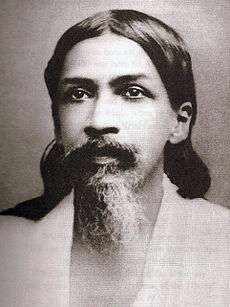Savitri: A Legend and a Symbol
| Sri Aurobindo |
|---|
 |
|
Family
|
|
Speeches and books |
|
Teachings |
|
Places |
|
Communities |
|
Disciples
|
|
Journals and Forums |
Savitri: A Legend and a Symbol is an epic poem in blank verse by Sri Aurobindo, based upon the theology from the Mahabharata. Its central theme revolves around the transcendence of man as the consummation of terrestrial evolution, and the emergence of an immortal supramental gnostic race upon earth. Unfinished at Sri Aurobindo's death, Savitri approaches 24,000 lines.
Introduction
Savitri is the masterpiece of Sri Aurobindo published in two parts in 1950 and 1951. He revised the book eighteen times before publishing it and it took nearly fifty years for completion. It consists of 12 books, and there are 49 cantos in it which further consist of about 24,000 lines. Sri Aurobindo had intended to write a lengthy introduction to Savitri, which never occurred. He did, however, write an author's note which functions as an effective summary that appears at the beginning of the poem in all its published versions. It reads:
- "The tale of Satyavan and Savitri is recited in the Mahabharata as a story of conjugal love conquering death. But this legend is, as shown by many features of the human tale, one of the many symbolic myths of the Vedic cycle. Satyavan is the soul carrying the divine truth of being within itself but descended into the grip of death and ignorance; Savitri is the Divine Word, daughter of the Sun, goddess of the supreme Truth who comes down and is born to save; Aswapati, the Lord of the Horse, her human father, is the Lord of Tapasya, the concentrated energy of spiritual endeavour that helps us to rise from the mortal to the immortal planes; Dyumatsena, Lord of the Shining Hosts, father of Satyavan, is the Divine Mind here fallen blind, losing its celestial kingdom of vision, and through that loss its kingdom of glory. Still this is not a mere allegory, the characters are not personified qualities, but incarnations or emanations of living and conscious Forces with whom we can enter into concrete touch and they take human bodies in order to help man and show him the way from his mortal state to a divine consciousness and immortal life."
Reviews
The Mother, who was Sri Aurobindo's spiritual collaborator, said this of Savitri: "... everything is there: mysticism, occultism, philosophy, the history of evolution, the history of man, of the gods, of creation, of Nature. How the universe was created, why, for what purpose, what destiny - all is there. You can find all the answers to all your questions there. Everything is explained, even the future of man and of evolution, all that nobody yet knows. He has described it all in beautiful and clear words so that spiritual adventurers who wish to solve the mysteries of the world may understand it more easily."[1]
Composition
Sri Aurobindo worked on Savitri for over twenty years, making it his literary life's work, with the earliest known draft written in 1916. Towards the beginning of the poem's composition, it was not uncommon for passages to undergo as many as ten redrafts, with many rearrangements of lines. In later years, as Sri Aurobindo's eyesight was failing, he dictated portions of the book to Nirodbaran. Just before his death, he fluently dictated lengthy passages with little to no correction afterwards.
History of publication
Savitri was originally brought out canto by canto in small fascicles and in periodicals published by the Sri Aurobindo Ashram. These periodicals were the Sri Aurobindo Mandir Annual, in 1946 and 1947, the quarterly Advent in 1946 and 1947, and the Sri Aurobindo Circle Annual in 1947. These installments were also made available simultaneously in fascicles Canto-wise. The fascicles covered the first four Cantos of Book 1 and Book 3. The fifteen Cantos of Book 2 were published in book-form in two parts, Cantos 1-6 and Cantos 7-15, in 1947 and 1948 respectively.
The whole poem first appeared in book-form in two parts in 1950 and 1951. Sri Aurobindo's letters written to his disciples on various aspects of the poem are now part of the book. This modern epic written in a modern language is also a modern day scripture. It recounts the saga of human victory over ignorance and conquest of death. Painstakingly composed in a rhythmic pentameter, each line of the poem is suffused with power of Mantra.
Many students and disciples of Sri Aurobindo and the Mother draw inspiration from Savitri for their spiritual growth. Many even find the answers to their doubts and questions by opening the book at random. On special occasions, continuous recitation of Savitri on a relay basis is also quite common in the Centers where the works and yoga teachings of The Mother and Sri Aurobindo are studied and practiced. Regular camps and conclaves are also organized at different places in the world to study the poem.
Editions
- ed. Aurobindo Ghose, Sri Aurobindo Ashram (1954) ASIN B0007ILK7W
- Lotus Press (1995) ISBN 0-941524-80-9
Literature
- Jugal Kishore Mukherjee, The ascent of sight in Sri Aurobindo's Savitri (2001) ISBN 81-7058-656-9
- D. S. Mishra, Poetry and philosophy in Sri Aurobindo's Savitri (1989) ISBN 81-85151-21-0
References
- ↑ Sarkar, Mona Sweet Mother. Sri Aurobindo Ashram Trust, 1978, p. 26.
External links
- Savitri Recording by Shraddhavan
- Official online text
- The Mother on Savitri
- Information on Sri Aurobindo and his writings